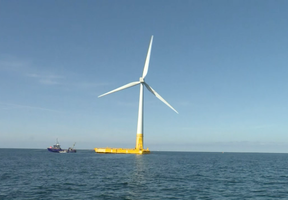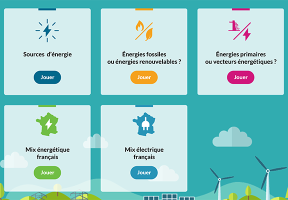
13. Offshore Fields Have Long Lives
The Anguille field offshore Gabon is an example of the renovation of a mature field, in production for 40 years. Another 21 wells will be drilled in a water depth of 30 meters, from a new platform. The unmanned rig is remotely operated and controlled. Flaring has been reduced 90%. Oil companies are trying to do away with or reduce the flaring performed to eliminate the gas associated with oil production.

1. The Global Surge in Offshore Production
and gas production is on a steady upward trend, accounting for 30% of the oil and 27% of the gas produced worldwide in 2013. And so-called "ultra-deep" , which refers to a water depth of over 1,500 meters, represents an increasingly large share of production. At depths of more than 400 meters, platforms on the seabed are replaced by semi-submersible central processing facilities (CPF) or immense floating barges called FPSOs. This shows the Laggan field rig, near the Shetland Islands.

2. The North Sea Platforms
The first offshore platforms were installed in fairly shallow water (less than 400 meters). They are supported by concrete pillars or foundations placed on the seabed. The North Sea is dotted with more than 450 installations of this kind, usually comprised of a main production platform, living quarters connected by a bridge and a helicopter landing pad.

3. Constant Surveillance
Control room of the Grondin rig offshore Port Gentil, in Gabon. The control room manages all operations, monitors measurement devices and relays voice messages, especially alerts, to the various teams at work, all from a single location.

4. Indispensible Helicopter
Crews travel to and from rigs by helicopter. All personnel must wear waterproof suits with life jackets to ensure their survival at sea while they await rescue in the event of an accident. Baggage checks are very strict: no hazardous objects, alcohol or cigarette lighters are allowed. Smoking on platforms is prohibited.

5. Night Work
Work on platforms continues around the clock (pictured here is the Paragon L1115, offshore Qatar), and day and night shift teams relay one another. Crews usually work two weeks in a row and then have time off for a period at least that long.

6. Non-Work-Related Living Areas
Living quarters include rooms – usually two or three bunks, sometimes singles – a cafeteria, lounges and sports rooms. Pictured here is the television room on the L7CC rig in the North Sea, offshore the Netherlands. A sick bay provides first aid (the most common cause of accidents is falling on stairs or iron girders, which are often slippery).

7. Safety Requirements
Safety is a top-of-mind concern on oil or gas rigs. A special motor powers the pumps that would be used to put out a fire. Oil workers still remember the horrible Piper Alpha accident off the coast of Scotland on July 6, 1988, which killed 167 people, and the Deepwater Horizon rig accident on April 20, 2010 in the Gulf of Mexico (11 fatalities). This picture shows two electricians aboard Grondin, offshore Port Gentil in Gabon.

8. Semi-Submersible Platforms
Floating platforms, equipped with ballast and anchored on the seabed to keep them from drifting, are used at water depths exceeding 400 meters. This photo shows the West Phoenix rig of the Laggan gas field, 125 kilometers west of the Shetland Islands. It is connected to the Tormore field. Drilling is performed at a water depth of 600 meters, through sedimentary layers to a depth of 3,000 meters. Subsea flowlines bring its production to shore.

9. Drillships
Deepwater subsea drilling is performed by specialized ships with dynamic positioning systems, called drillships. Leasing a drillship in Europe costs around €1 million a day. Pictured here is the West Gemini, during operations offshore Angola.

10. Like a Huge Stationary Cruise Ship
Ultra-deep or very far offshore fields are produced using immense barges, called FPSOs for Floating Production Storage and Offloading vessel. They produce, store and load oil and gas aboard tankers. The Pazflor FPSO, anchored offshore of Angola, covers 49 subsea wells scattered over 600 sq. kilometers (six times the area of Paris), at water depths ranging from 600 to 1,200 meters.

11. As Big as Three Football Fields
Total installed its fourth FPSO located over Angola's offshore fields in December 2014. The project is called CLOV. In the foreground, lifeboats can be launched if an order to evacuate the barge by sea is issued. Built in four months for $8 billion, CLOV is 305 meters long and 61 meters wide.

12. A Regular Underwater Plant
Development plan for the deepwater Akpo field offshore Nigeria. Twenty flexible lines bring the products to the surface and another 22 inject the water and gas used to move them in the direction of the production well. More and more technical tasks are being done on the seabed, which involves installing and managing many pieces of equipment. The Akpo field produces condensates and gas.

13. Offshore Fields Have Long Lives
The Anguille field offshore Gabon is an example of the renovation of a mature field, in production for 40 years. Another 21 wells will be drilled in a water depth of 30 meters, from a new platform. The unmanned rig is remotely operated and controlled. Flaring has been reduced 90%. Oil companies are trying to do away with or reduce the flaring performed to eliminate the gas associated with oil production.

1. The Global Surge in Offshore Production
and gas production is on a steady upward trend, accounting for 30% of the oil and 27% of the gas produced worldwide in 2013. And so-called "ultra-deep" , which refers to a water depth of over 1,500 meters, represents an increasingly large share of production. At depths of more than 400 meters, platforms on the seabed are replaced by semi-submersible central processing facilities (CPF) or immense floating barges called FPSOs. This shows the Laggan field rig, near the Shetland Islands.

2. The North Sea Platforms
The first offshore platforms were installed in fairly shallow water (less than 400 meters). They are supported by concrete pillars or foundations placed on the seabed. The North Sea is dotted with more than 450 installations of this kind, usually comprised of a main production platform, living quarters connected by a bridge and a helicopter landing pad.

3. Constant Surveillance
Control room of the Grondin rig offshore Port Gentil, in Gabon. The control room manages all operations, monitors measurement devices and relays voice messages, especially alerts, to the various teams at work, all from a single location.

4. Indispensible Helicopter
Crews travel to and from rigs by helicopter. All personnel must wear waterproof suits with life jackets to ensure their survival at sea while they await rescue in the event of an accident. Baggage checks are very strict: no hazardous objects, alcohol or cigarette lighters are allowed. Smoking on platforms is prohibited.

5. Night Work
Work on platforms continues around the clock (pictured here is the Paragon L1115, offshore Qatar), and day and night shift teams relay one another. Crews usually work two weeks in a row and then have time off for a period at least that long.

6. Non-Work-Related Living Areas
Living quarters include rooms – usually two or three bunks, sometimes singles – a cafeteria, lounges and sports rooms. Pictured here is the television room on the L7CC rig in the North Sea, offshore the Netherlands. A sick bay provides first aid (the most common cause of accidents is falling on stairs or iron girders, which are often slippery).

7. Safety Requirements
Safety is a top-of-mind concern on oil or gas rigs. A special motor powers the pumps that would be used to put out a fire. Oil workers still remember the horrible Piper Alpha accident off the coast of Scotland on July 6, 1988, which killed 167 people, and the Deepwater Horizon rig accident on April 20, 2010 in the Gulf of Mexico (11 fatalities). This picture shows two electricians aboard Grondin, offshore Port Gentil in Gabon.

8. Semi-Submersible Platforms
Floating platforms, equipped with ballast and anchored on the seabed to keep them from drifting, are used at water depths exceeding 400 meters. This photo shows the West Phoenix rig of the Laggan gas field, 125 kilometers west of the Shetland Islands. It is connected to the Tormore field. Drilling is performed at a water depth of 600 meters, through sedimentary layers to a depth of 3,000 meters. Subsea flowlines bring its production to shore.

9. Drillships
Deepwater subsea drilling is performed by specialized ships with dynamic positioning systems, called drillships. Leasing a drillship in Europe costs around €1 million a day. Pictured here is the West Gemini, during operations offshore Angola.

10. Like a Huge Stationary Cruise Ship
Ultra-deep or very far offshore fields are produced using immense barges, called FPSOs for Floating Production Storage and Offloading vessel. They produce, store and load oil and gas aboard tankers. The Pazflor FPSO, anchored offshore of Angola, covers 49 subsea wells scattered over 600 sq. kilometers (six times the area of Paris), at water depths ranging from 600 to 1,200 meters.

11. As Big as Three Football Fields
Total installed its fourth FPSO located over Angola's offshore fields in December 2014. The project is called CLOV. In the foreground, lifeboats can be launched if an order to evacuate the barge by sea is issued. Built in four months for $8 billion, CLOV is 305 meters long and 61 meters wide.

12. A Regular Underwater Plant
Development plan for the deepwater Akpo field offshore Nigeria. Twenty flexible lines bring the products to the surface and another 22 inject the water and gas used to move them in the direction of the production well. More and more technical tasks are being done on the seabed, which involves installing and managing many pieces of equipment. The Akpo field produces condensates and gas.

13. Offshore Fields Have Long Lives
The Anguille field offshore Gabon is an example of the renovation of a mature field, in production for 40 years. Another 21 wells will be drilled in a water depth of 30 meters, from a new platform. The unmanned rig is remotely operated and controlled. Flaring has been reduced 90%. Oil companies are trying to do away with or reduce the flaring performed to eliminate the gas associated with oil production.
 This may interest you
This may interest you
See all





















